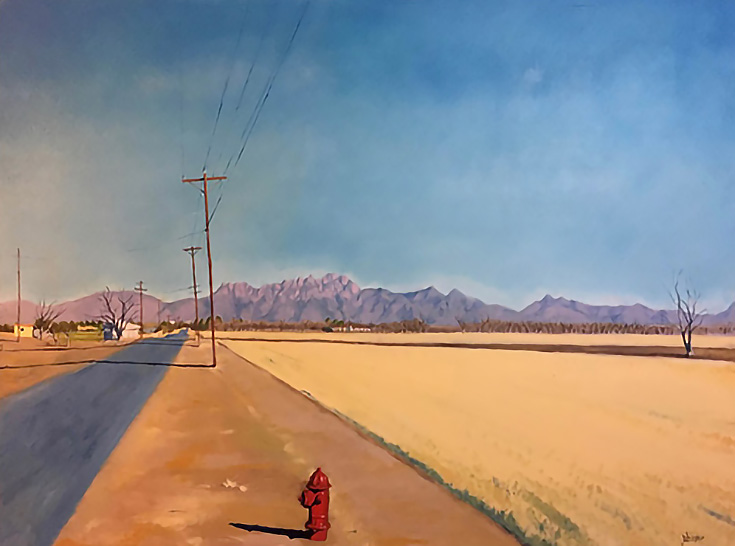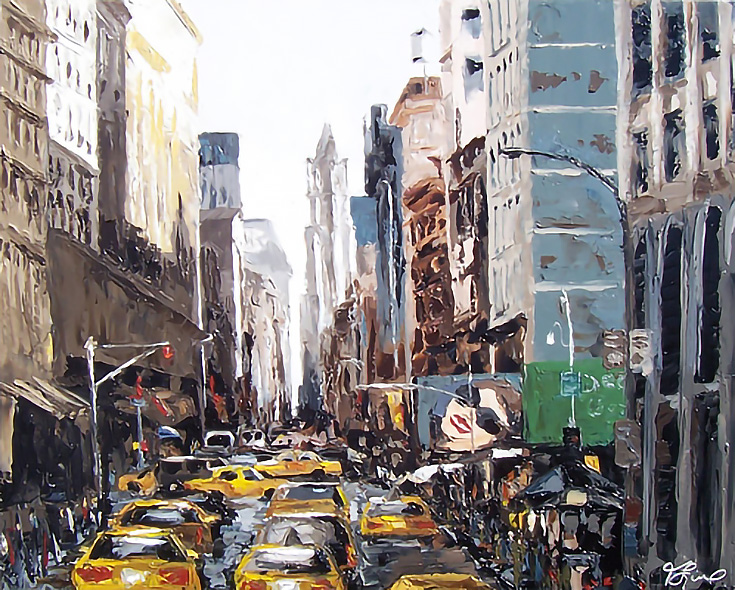Have you ever noticed how art magazines, art blogs, art classes and instructional books often call bright greens “garish”? Many will suggest avoiding green paint straight from the tube, and instead will tell you to mix your own greens from blue and yellow paint for a better effect.
Generally that “better effect” is a less intense color. . . unless you’re using Pthalo Blue mixed with a very clean, very cold yellow.
This aversion to bright greens can be puzzling, especially if you look outside at nature and bright greens abound. After all, why would anyone recommend against brilliant turquoise, emerald and lime hues if that’s what’s all around you?
The answer to that question may (at least in part) relate to the instructor’s location: specifically, his or her latitude. The chart below illustrates some of the color differences between geographic areas in the US:
Northern colors
In the northern US near Canada, the sky is pale and quite warm. . . for a blue, that is. It’s actually close to a purple-blue. Ultramarine renders it well, especially thinned and possibly muted a little with a touch of orange. Half the time in winter the sky seems white, and it can be so silvery pale that it’s barely blue at all.
Up there in the North, blues and greens on the ground seem faded and muted. Autumn foliage blazes bright and clear with oranges, reds and yellows, while the greens take a back seat. Even dried vegetation shines with gold.
The changing Midwest
If you go south a bit more toward the Midwest, you’ll find much more color in the sky. The summer sky will be a darker blue, and the greens brighter at the height of summer. In the winter though, the same faded colors can be found across the landscape as those farther north.
Bring a sprig of evergreen inside and you’ll see rich, deep, sap-green or blue-green hues. Take it outdoors in the middle of the Midwest winter and a cold grayish light will suck out half its intensity.
Painters who create beautiful, vibrant winter scenes often intensify the colors seen in nature, or paint at dawn and sunset, when the angle of the sun is lower and more golden and pinkish rays come in to blaze off the snow.
Southern skies and landscapes
Leave the Midwest behind, heading south and west, and you’ll find brilliant violet shadows, glowing red and orange stones, and blazing blue skies that lean toward greenish blues like Pthalo rather than Ultramarine.
Greens in the south tend to be muted because of the aridity and dust, but everything else has great intensity. The American desert comes alive with color, and it’s not just because red sandstone is brighter than Northern rocks. . . it’s because of the latitude.
Eastbound on Glass Road, Mesilla, New Mexico by J.S. Brown
Southwest art is painted under a southern sky that is nearly turquoise, colder and greener than the sky in the North. This makes the greens and blues of the landscape blaze. There’s also more light in general in the South because the sun is closer to the Earth nearer to the equator.
When you go east from the Southwest desert, moisture will slowly seep into the environment, creating blazingly intense greens all around. Even pine trees are rich with a sap-green or blue-green hue. Deciduous plants scream with color, bearing large showy flowers that you can paint with bright, pure, pigment straight from the tube.
Local colors are king
Several pastel manufacturers, aware of these color differences in local landscapes, have put together different collections for different regions. For instance, Mount Vision Pastel Co. has recently created a tropical set of 25 colors for rendering Florida’s skies, vegetation, and rich turquoise waters.
These colors would feel out of place in the North, but for Florida (and perhaps the Carribbean, in a pinch) it’s a set of colors worth having.
Of course, if you’re painting in a more urban environment, it doesn’t matter nearly as much where you are on the globe.
City scenes often demand a grayed-out palette because of industrial smoke, pollution, dust from traffic and the endless dirt circulated from human activity. There may be some artificially bright elements in a city street – like people’s clothing, taxi cabs, and signs on buildings—yet the signs rarely stay clean and all of the light is at least somewhat neutralized by the dust and smog in the air.
New York Traffic by Trisha Lamoreaux
It’s all about knowing your location
Ultimately, when choosing a palette for any type of art, always consider the location. Keep your latitude in mind, and if going south, don’t hesitate to purchase and work with brighter colors than you think you’ll need. Travel photos from cruises may look so brightly colored as to seem unreal to a Northern eye—but they’re true to life. The world really is that much more colorful closer to the equator than it is up North.
So scout your location before you visit it by talking to artists who live there and viewing photos from the region (the internet makes this very easy). Ask local artists what their favorite colors are for landscape painting. Keep these and other color observations in mind, but always believe your own eyes over any “recipes” you find. The better you observe nature, the truer your paintings will be, no matter where you are in the world.
This post may contain affiliate links.



